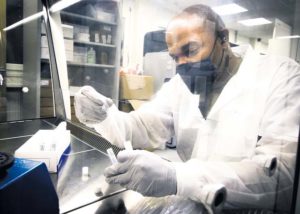
Landstuhl Regional Medical Center recently exceeded 50,000 COVID-19 tests in its effort to slow the spread of the virus overseas.
Starting in February, LRMC’s Infectious Diseases Laboratory began testing for COVID-19 utilizing the Real-Time Reverse Transcriptase Diagnostic Panel, becoming the only U.S. military medical treatment facility in Europe with diagnostic testing capabilities. As the threat of COVID-19 increased, so has demand for testing, resulting in the addition of rapid multiplex polymerase chain reaction, and a high-throughput testing system which provides rapid, high-volume testing of COVID-19 test samples.
Various efforts initiated across Europe, Africa and the Middle East, have led to increased testing for surveillance, screening and symptomatic testing since the start of the pandemic.
“Although this is a large number of samples, it doesn’t fully capture the extent of the broader and more comprehensive laboratory team approach,” said U.S. Army Lt. Col. David Peterson, chief of LRMC’s Department of Pathology. “Over the last several months the LRMC lab directors and their outlying clinic laboratories have set up COVID-19 testing capabilities at more than 10 military health clinic sites bringing valuable testing closer to the patients and operational units.”
Personnel, ranging from PhD-level scientists to supply technicians, support the laboratory, allowing the section to continue daily mission requirements of providing non-COVID-19 analysis while continuing to support the hospital’s ongoing and increasing COVID-19 mission.
Across Europe, the U.S. Army has performed PCR testing on more than 150,000 COVID-19 samples in collaboration with various Army Health Clinics, to include clinics across Germany, Belgium and Italy, and Public Health Command Europe.
According to Peterson, the testing not only helps with tracking and slowing the spread of COVID-19, but in conjunction with other testing, helps identify other causes of respiratory illness, such as influenza and other viruses.
“Some of our testing helps symptomatic individuals differentiate between COVID-19 infection and non-COVID infections, which can aid in treatment and disposition decisions,” said Peterson. “In the event of an illness affecting schools and the work environment, testing is essential to identify close contacts and others that may have been exposed so measures can be taken to protect those that were not exposed.”
Additionally, Peterson mentions surveillance testing capabilities in austere environments can help identify asymptomatic individuals before the virus spreads within a unit, increasing combat readiness for Joint Warfighters across the combatant commands. The testing also allows U.S. service members to continue multinational training exercises overseas while ensuring host-nation communities remain safe from the virus.
“In total, we have received samples from over 40 different locations within Europe, Africa and the Middle East. These are from a combination of Army, Air Force, Navy and Marine Corps sites, as well as forward-deployed units and some U.S. Department of State affiliated locations,” said Peterson. “The aim of much of our testing is to identify symptomatic and asymptomatic infection as early as possible so that action can be taken to reduce, hopefully prevent additional spread and ultimately protect individuals and communities and conserve military readiness.”


